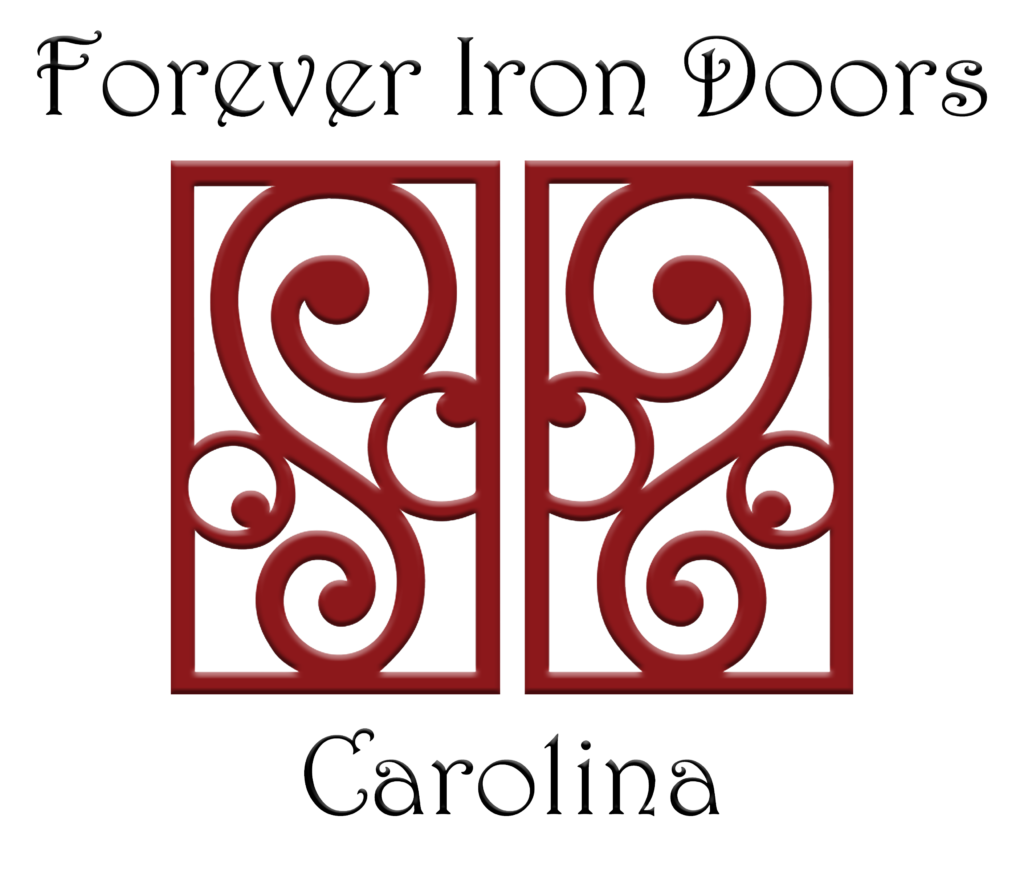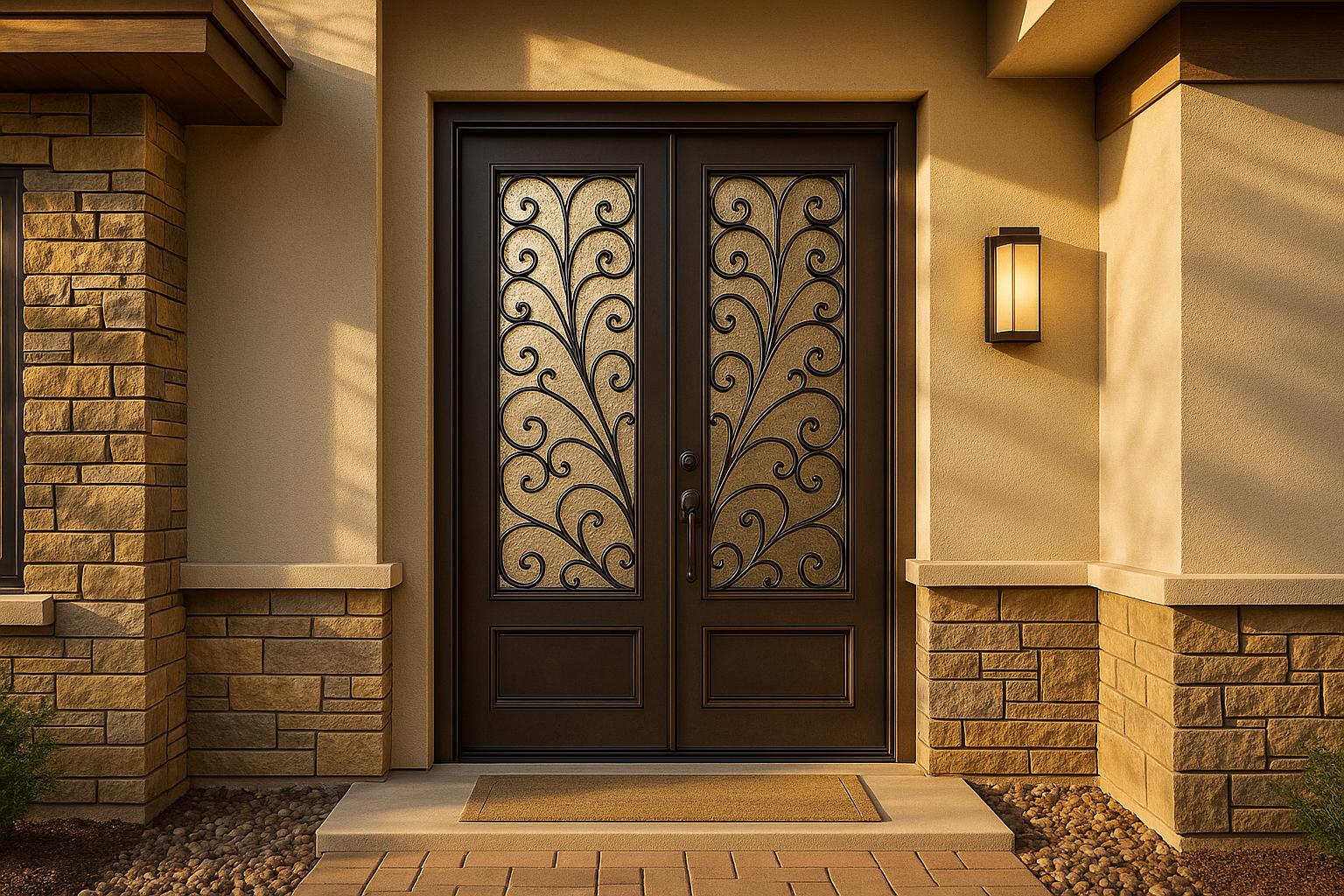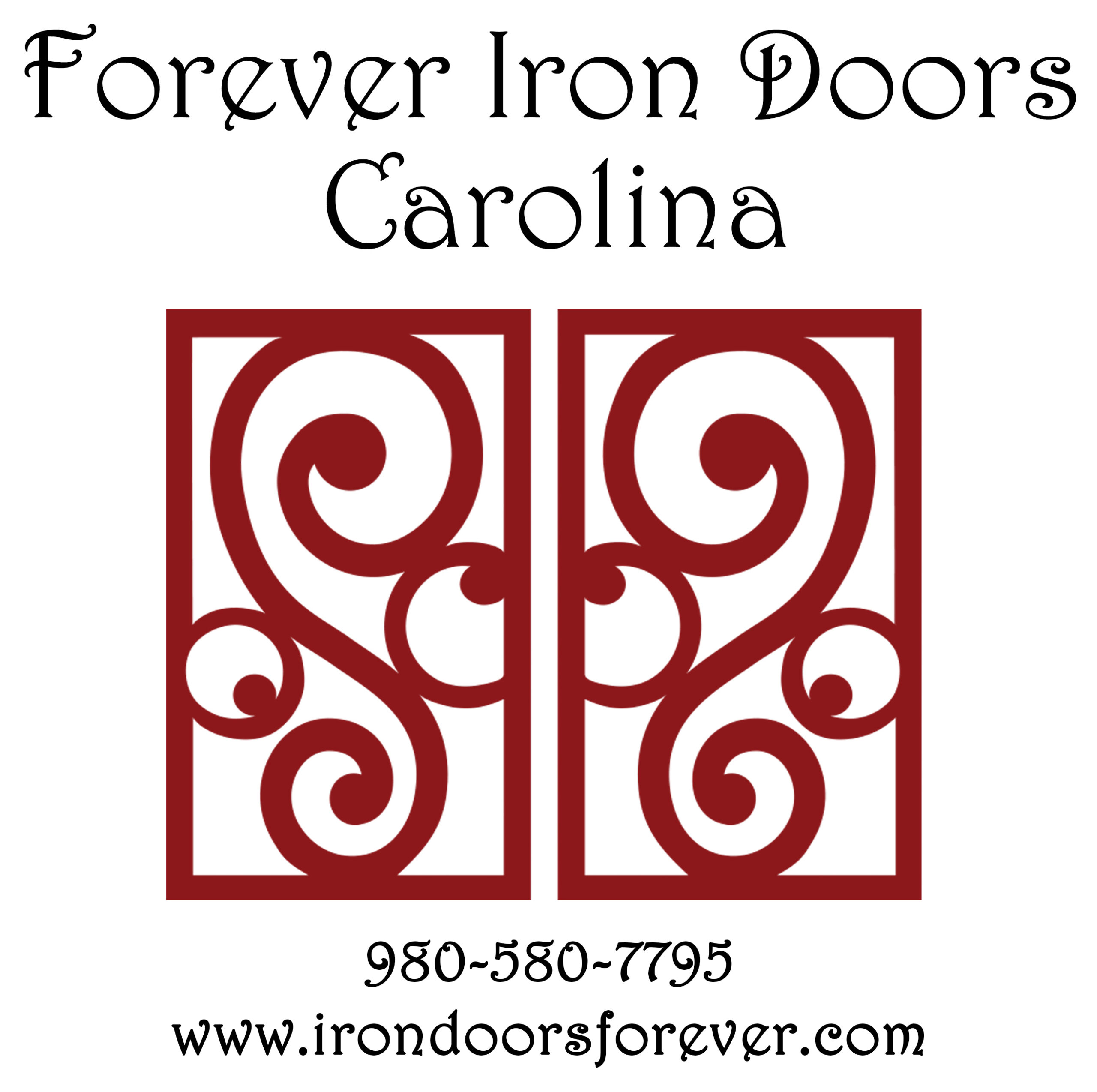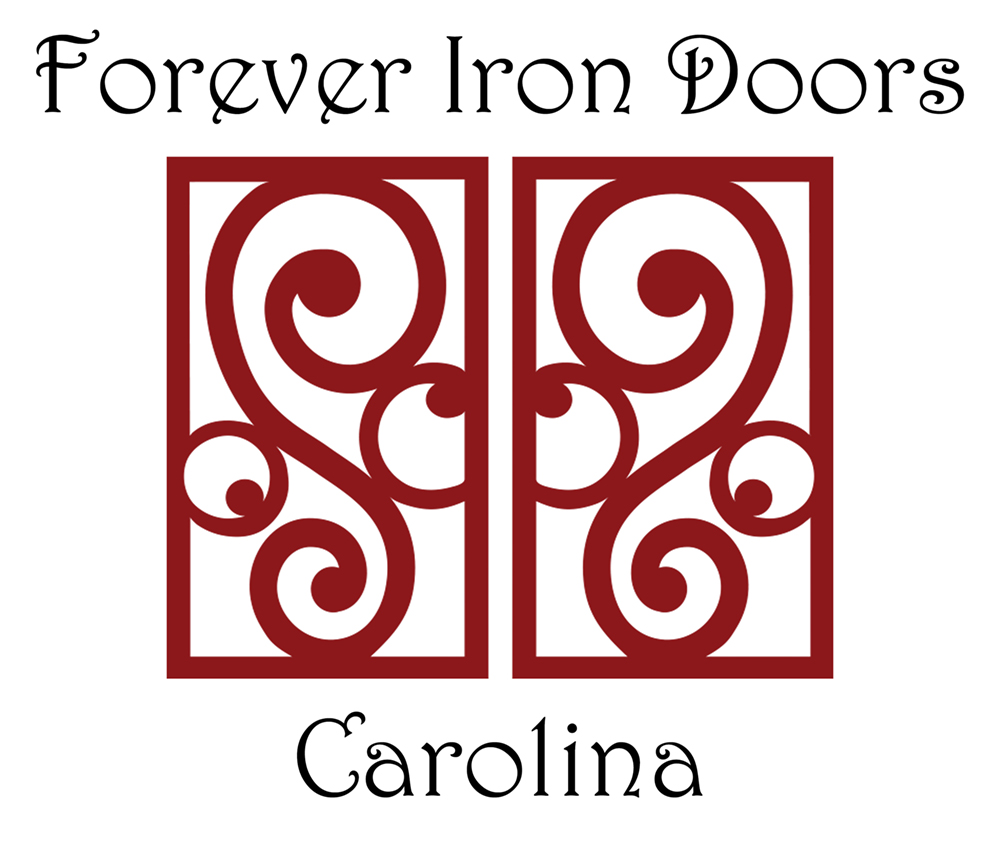Iron doors are more than just a stylish entryway – they can help you save on energy costs. With features like insulated cores, thermal break technology, and weatherstripping, they reduce energy loss, keeping your home comfortable year-round. Compared to materials like wood, fiberglass, and steel, iron doors offer durability, better temperature control, and long-term performance. While they tend to cost more upfront ($2,500–$8,000), their longevity and energy-saving capabilities make them a smart investment.
Key Features of Energy-Efficient Iron Doors:
- Thermal Breaks: Reduce heat transfer by up to 50%.
- Insulated Cores: Maintain consistent indoor temperatures.
- Weatherstripping: Prevents drafts and air leaks.
- Energy-Efficient Glass: Double or triple glazing minimizes energy loss.
Why Choose Iron Doors Over Other Materials?
- Durability: Lasts 50–100+ years, far outlasting wood or fiberglass.
- Security: Strong construction adds protection.
- Low Maintenance: Resistant to warping and wear.
To maintain efficiency, ensure proper installation, inspect weatherstripping regularly, and clean the door twice a year. Upgrades like better insulation or Low-E glass can further enhance performance. Iron doors not only lower utility bills but also add lasting value and curb appeal to your home.
Energy-Efficient Iron Door Features
Today’s iron doors go beyond just looking elegant – they’re equipped with advanced technologies that help cut down on energy loss. These updates make iron doors not only an attractive feature but also an important contributor to your home’s overall energy efficiency. Plus, they work beautifully with the added design and security perks these doors offer.
Thermal Break Technology
One standout feature is thermal break technology, which works by separating the door frame with a low-conductivity material, such as carbon or polyamide. This layer acts as a barrier to heat transfer, cutting energy loss by up to 50%. It also adds durability with an extra 1/8-inch thickness.
"A thermal break is created when a material of low thermal conductivity is placed between the door’s conductive materials to stop energy transfer. This thermal break acts as a barrier that reduces heat conduction through the door’s metal framing." – Dawson Metal
Insulated Cores for Better Temperature Control
Iron doors with insulated cores take energy efficiency a step further. These cores are often filled with materials like polyurethane foam (R-Factor 2.81, U-Factor 0.36) or alternatives such as polystyrene (R-Factor 2.64, U-Factor 0.38) and mineral wool. The result? A consistent indoor temperature and less strain on your heating or cooling systems.
Weatherstripping and Sealing
Proper sealing is a game-changer for keeping drafts out. High-quality weatherstripping, made from materials like silicone, EPDM rubber, neoprene, or specialized foam, works alongside door sweeps and caulked saddle thresholds to close any gaps. Professional installation techniques, such as using expanding foam or backer rods, ensure a tight seal. Routine maintenance keeps everything working like new.
Energy-Efficient Glass Options
If your iron door includes glass panels or sidelights, energy-efficient glass can make a big difference. Double- or triple-pane glazing, filled with air or argon, combined with Low-E coatings, helps reflect infrared energy and improves insulation. Well-fitted, insulated frames and NFRC-certified glass ensure there’s no thermal bridging or condensation.
Forever Iron Doors Carolina integrates all these energy-efficient features into their custom wrought iron doors. From thermal breaks to insulated cores and top-tier weatherstripping, they deliver doors that perform exceptionally while looking stunning.
Iron vs. Other Door Materials Performance
When it comes to entry doors, the material you choose can significantly affect energy efficiency, durability, and overall performance. Each material brings its own strengths and weaknesses, so understanding these differences can help you make a choice that balances comfort, security, and cost. Below is a comparison table highlighting how wrought iron stacks up against other popular door materials.
Material Comparison Table
| Material | Energy Efficiency (R-Value) | Durability (Years) | Security Level | Maintenance | Initial Cost Range |
|---|---|---|---|---|---|
| Wrought Iron | 2.5-3.5 (with insulation) | 50-100+ | High | Low | $2,500-$8,000 |
| Wood | 2.0-3.0 | 15-30 | Good | High | $1,500-$4,000 |
| Fiberglass | 2.5-4.0 | 20-40 | Good | Medium | $1,200-$3,500 |
| Steel | 1.5-2.5 | 20-35 | Very Good | Medium | $800-$2,500 |
Why Wrought Iron Excels in Energy Efficiency
Wrought iron doors stand out for their ability to combine energy efficiency with exceptional durability. Unlike wood, which can warp or shrink over time, iron doors maintain a tight seal for decades. This consistent performance ensures that energy efficiency doesn’t diminish as the years go by.
Iron’s thermal mass plays a unique role in regulating indoor temperatures. During hot summers, it absorbs heat at a slower rate, helping to keep interiors cooler. In the winter, it retains warmth, reducing the workload on your HVAC system and keeping your home comfortable.
Other materials have their drawbacks when it comes to energy efficiency. Steel doors, for instance, often use thinner materials that conduct heat more easily, leading to higher energy loss. Wrought iron’s thicker construction minimizes thermal bridging, a common issue where heat escapes through the material itself.
Wood doors, while visually appealing, are prone to seasonal expansion and contraction. These shifts can create gaps that allow air to seep in, undermining energy efficiency. Even with regular maintenance, wood doors can lose their effectiveness over time, requiring costly replacements.
Fiberglass doors offer decent energy efficiency initially, but they aren’t without flaws. Exposure to UV rays and extreme temperatures can cause cracking or fading, which not only affects their appearance but also compromises their performance.
Another advantage of wrought iron is its ability to withstand physical stress without compromising its energy-efficient seals. In contrast, other materials like wood or fiberglass may sustain frame damage during attempted break-ins, leading to permanent air leaks.
Forever Iron Doors Carolina takes these benefits a step further by incorporating modern insulation technologies. Features like thermal break systems and insulated cores enhance the energy efficiency of their wrought iron doors, delivering R-values that rival or exceed those of other materials. This combination of durability, security, and energy performance makes wrought iron doors a smart long-term investment for homeowners focused on reducing energy costs.
Home Value and Curb Appeal with Iron Doors
Energy-efficient wrought iron doors don’t just reduce energy costs – they also elevate your home’s value with their blend of premium materials, durability, and eye-catching design.
Property Value Benefits
Adding wrought iron doors to your home can significantly increase its market value. These doors offer long-term energy savings, require minimal upkeep, and provide a secure, high-quality entry point. Real estate experts often rank front door upgrades among the most impactful home improvements, as energy-efficient iron doors address key buyer concerns like security, performance, and contemporary design. Built to last for decades, these doors retain their value over time, making them a wise investment. Plus, their enhanced security features could even help lower your insurance costs.
Beyond their practical benefits, these doors make a bold statement, redefining your home’s exterior with a unique, personalized touch.
Curb Appeal and Customization
A custom wrought iron door serves as more than just an entryway – it becomes a centerpiece of your home’s exterior design. Homeowners can personalize nearly every aspect of these doors, from glass styles to hardware finishes, creating an entrance that reflects their taste and complements their home’s architecture.
Forever Iron Doors Carolina provides a wide range of customization options to help you design the perfect door. Their glass choices include clear, frosted, textured, and decorative patterns, offering both privacy and aesthetic appeal. Finishes range from timeless black to aged bronze, rust patina, and antique copper, ensuring your door harmonizes with any exterior color palette.
You can also select custom hardware, such as handles and hinges, to complete your design. Want to go further? Incorporate intricate scrollwork, geometric patterns, or even a personalized monogram into the door’s design. These custom elements not only enhance the door’s appearance but also maintain its structural integrity. This level of detail adds a touch of luxury that makes your home stand out, boosting curb appeal and neighborhood admiration.
The combination of personalized design and durable construction makes wrought iron doors a magnet for potential buyers. Their bespoke features signal quality and attention to detail throughout the property, while the low-maintenance and long-lasting nature of these doors make them a practical choice for any homeowner. With expert installation from Forever Iron Doors Carolina, you can enjoy a door that delivers both performance and timeless beauty.
sbb-itb-cd90297
Maintaining Iron Door Efficiency
Keeping your iron door in top shape ensures it stays energy-efficient and prevents unnecessary energy loss. Even the best-installed doors need proper care to maintain their performance over time.
Professional Installation for Maximum Efficiency
Energy efficiency begins with a flawless installation. Proper fitting eliminates air leaks that could compromise the door’s thermal performance.
At Forever Iron Doors Carolina, installation is more than just putting the door in place. Their service includes structural framing and moisture sealing, ensuring everything fits perfectly. Expert installers align the door precisely and ensure the weatherstripping makes full contact, eliminating gaps and reducing the risk of settling over time.
Moisture sealing is another critical step. Professionals apply weatherproof sealants around the frame and use flashing techniques to direct water away from vulnerable areas. This protects the door from moisture damage, which can warp frames and create air gaps, helping your door maintain its energy efficiency for years to come.
Routine Maintenance Tips
Once your door is professionally installed, regular maintenance is key to keeping it efficient. Here are some simple steps to follow:
- Inspect weatherstripping and door sweeps: Check these every six months for signs of wear, such as cracks or flattening. Good weatherstripping should compress snugly when the door closes and spring back into shape when open.
- Clean your door: Twice a year, wash the door with mild soap and water. Pay extra attention to glass panels and frame joints to remove dirt and debris. This not only ensures a proper seal but also prevents corrosion. After cleaning, apply a rust-resistant coating to protect the finish.
- Check glass panels: Look for condensation between double-pane glass, which signals a seal failure and reduced insulation. Tighten any loose hardware around the panels to prevent air leaks.
Upgrades and Improvements
Over time, you can enhance your iron door’s energy efficiency with a few upgrades:
- Add insulation: For older doors, retrofitting with rigid foam board or polyurethane foam inside the door cavities significantly improves thermal performance, reducing heat transfer.
- Upgrade weatherstripping: High-performance weatherstripping can further cut down on drafts and air leaks. Replace worn-out materials as needed to maintain a tight seal.
- Enhance glass panels: Switching from single-pane to double- or triple-glazed glass with Low-E coatings can make a big difference. These coatings reflect infrared energy while still allowing natural light to pass through. Ensure the glass panels fit tightly and are properly insulated around the edges for maximum efficiency.
- Improve thresholds: Upgrading to adjustable thresholds helps maintain a snug seal over time, especially as weatherstripping compresses or as your home naturally settles.
Regular care and strategic upgrades will keep your iron door performing at its best, saving energy and enhancing comfort in your home.
Conclusion: Iron Door Energy Efficiency Benefits
Custom wrought iron doors deliver a mix of energy efficiency, durability, and timeless design that elevates both the functionality and value of your property. With features like thermal break technology and insulated cores, these doors help lower energy bills while standing strong for years to come.
By reducing utility costs and enhancing property appeal, iron doors prove to be a smart, long-term investment. Their sturdy construction means fewer replacements compared to other materials, and with regular upkeep, they can remain efficient for decades.
With Forever Iron Doors Carolina, you can customize your door to include energy-efficient glass, thermal-resistant finishes, and tailored hardware to match your style while improving performance. Options like double-glazed Low-E glass provide excellent insulation, while decorative panels maintain thermal protection without compromising on aesthetics.
Proper installation and consistent maintenance are key to preventing air leaks and ensuring your door operates at its best. Over time, strategic upgrades like better insulation or improved thresholds can further enhance their efficiency.
In the varying climates of North and South Carolina, iron doors help keep homes cool during the summer and warm during the winter, reducing the load on HVAC systems. By merging elegant design with energy-saving features, these doors offer a modern solution for homeowners seeking both style and practicality.
FAQs
How do thermal break technology and insulated cores make iron doors more energy-efficient?
Thermal break technology boosts the energy efficiency of iron doors by incorporating an insulating layer between the inner and outer metal frames. This layer acts as a barrier, cutting down on heat transfer. The result? Your home stays cooler during scorching summers and cozier during chilly winters.
Additionally, insulated cores – commonly made from materials like polyurethane or polystyrene – take energy efficiency a step further. They help minimize heat loss and maintain consistent indoor temperatures. These features not only help reduce energy bills but also make wrought iron doors a smart and stylish choice for homes in a variety of climates, whether hot or cold.
What can I do to keep my iron doors energy-efficient over time?
To keep your iron doors energy-efficient, make it a habit to inspect and replace the weatherstripping every year. This simple step helps maintain a tight seal, keeping drafts out and your indoor temperature stable. Also, check the door’s alignment twice a year – foundation shifts or regular use can create gaps that let air escape.
Another way to boost efficiency is by insulating the door core. Since iron is a good conductor of heat, proper insulation reduces heat transfer, helping your home stay cozy in winter and cool in summer. Don’t forget regular upkeep like cleaning, sealing, and rust prevention. These small efforts go a long way in preserving the durability, functionality, and energy performance of your iron doors for years to come.
How do wrought iron doors compare to wood and fiberglass in durability and energy efficiency?
Wrought iron doors are known for their durability and energy-saving qualities. Built with dense, heavy iron, they offer strong thermal insulation, especially when combined with quality seals and insulation materials. This combination helps minimize heat transfer, keeping your home cozy in winter and cool in summer, which can also help cut down on energy bills.
Many modern wrought iron doors are designed to meet Energy Star standards, potentially reducing energy consumption by up to 12% or more. Their sturdy construction not only ensures consistent indoor temperatures but also provides lasting benefits for homeowners over time.



